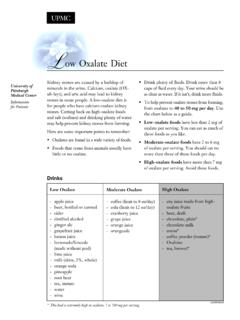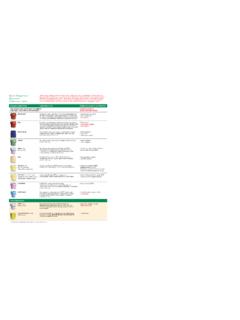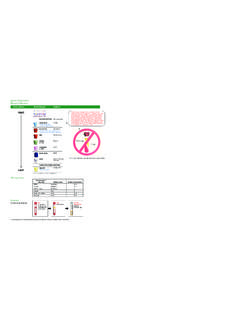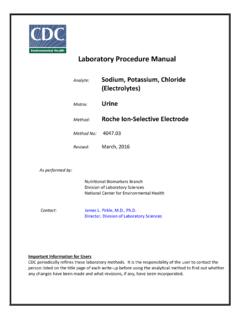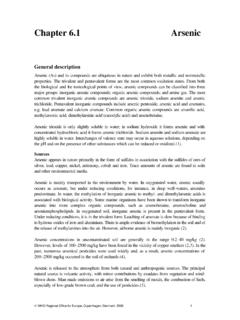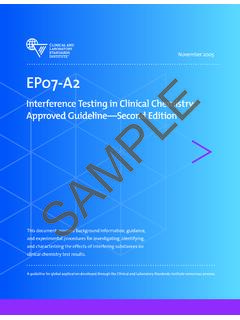Transcription of Urinalysis Testing Using Siemens Multistix 10 SG Reagent ...
1 CentraCare Laboratory Services 1 ACTION DATE INITIAL Adopted Reviewed 1/7/11 MAS Reviewed 1/10/12 MAS Reviewed Reviewed Revised 5/11/10 MAS Supersedes 2/6/08 name change from Bayer to Siemens TITLE: Urinalysis Testing Using Siemens Multistix 10 SG Reagent STRIPS Policy: Employees in Occupational Health will perform Urinalysis Testing for MnDOT employees. They are Testing primarily for specific gravity, albumin, and glucose and occult blood. These results will be given directly to the MnDOT employee.
2 A central laboratory employee will be responsible for qaulity assurance of this procedure. Principle: Siemens Multistix 10 SG Reagent strips are firm plastic strips to which are affixed several separate Reagent areas. Multistix 10 SG strips provide tests for glucose, bilirubin, ketones, specific gravity, blood, pH, protein, urobilinogen, nitrite, and leukocytes in urine. Test results may provide information regarding the status of carbohydrate metabolism, kidney and liver function, acid-base balance, and urinary tract infection. The Reagent test areas on the Multistix 10 SG strips are ready to use upon removal from the bottle and the entire Reagent strip is disposable. The strips are read visually.
3 The directions must be followed exactly. Accurate timing is essential to provide optimal results. The Reagent strips must be kept in the bottle with the cap tightly closed to maintain Reagent reactivity. To obtain optimal results, it is necessary to use FRESH, WELL-MIXED, uncentrifuged urine. For the chemical principles of each test area, please refer to the product insert found in the box with each bottle of Multistix 10 SG. Specimen Requirement: Collect urine in a clean container and test it as soon as possible. Do not centrifuge. The use of urine preservatives is not recommended. If Testing cannot be done within an hour after voiding, refrigerate the specimen immediately and let it return to room termperature before Testing .
4 Reagents and Equipment: Multistix 10 SG Reagent strips (see product insert for a complete list of reagents). Store at room temperature between 15-30 degrees C (59-86 degrees F).Do not use after expiration date. Do not store the bottle in direct sunlight. Clean, dry urine collection container Stopwatch or clock with a second hand Controls (positive and negative) for quality assessment-located in central laboratory Note: See central lab UA procedure for QC. Read strips visually. CentraCare Laboratory Services 2 Quality Control Each bottle of Multistix 10 SG Reagent strips will have QC performed Using known positive and negative controls.
5 This function will be carried out by central laboratory personnel. Please notify the central laboratory when opening a new bottle. Records of quality control will be kept in the central laboratory. If a bottle of strips fails to give the expected results, central lab personnel will notify Occupational Health. Procedure: MUST BE FOLLOWED EXACTLY TO ACHIEVE RELIABLE RESULTS 1. Collect fresh urine specimen in a clean, dry container. If specimen has been refrigerated, let it come to room temperature before Testing . Mix well immediately before Testing . 2. Remove one strip from the bottle of strips and replace the cap. Completely immerse Reagent areas of the strip in the urine and remove immediately to avoid dissolving out reagents.
6 3. While removing, run the edge of the strip against the rim of the urine container to remove excess urine. Hold the strip in a horizontal position to prevent possible mixing of chemicals from adjacent Reagent areas and/or contaminating the hands with urine. 4. Compare Reagent areas to coresponding color chart on the bottle label at the time specified. Hold strip close to color blocks and match carefully. Avoid laying the strip directly on the color chart, as this will result in the urine soiling the chart. PROPER READ TIME IS CRITICAL FOR OPTIMAL RESULTS. Read the glucose and bilirubin test at 30 seconds after dipping. Read the ketone test at 40 seconds; the specific gravity at 45 seconds; pH, protein, urobilinogen, blood, and nitrite at 60 seconds; and leukocytes at 2 minutes.
7 The pH and protein areas may also be read immediately or at any time up to 2 minutes after dipping. After dipping the strip, check the pH area. If the color on the pad is not uniform, read the Reagent area immediately, comparing the darkest color to the appropriate color chart. All Reagent areas except leukocytes may be read between 1 and 2 minutes for identifying negative specimens and for determination of the pH and specific gravity. A positive reaction (small or greater) at less than 2 minutes on the leukocyte test may be regarded as a positive indication of leukocytes in urine. Color changes that occur after 2 minutes are of no diagnostic value. Reporting Results Results are reported directly back to the patient in the amounts expressed on the charts on the bottle label.
8 Expected Values: Glucose: small amounts of glucose are normally excreted by the kidney, usually below the sensitivity of this test, but may, on occasion, produce a color between negative and 100 mg/dl that may be interpreted as positive. Results at the first positive level may be significantly abnormal if found consistently. CentraCare Laboratory Services 3 Bilirubin: normally no bilirubin is detectable in urine by even the most sensitive methods. Even trace amounts of bilirubin are sufficiently abnormal to require further investigation. Ketone: normal urine speciemens ordinarily yield negative results. Detectable levels of ketone may occur in urine during physiological stress conditions such as fasting, pregnancy, and frequent strenuous exercise.
9 In ketoacidosis, starvation, or other abnormalities of carbohydrate or lipid metabolism, ketones may appear in urine in large amounts before serum ketone is elevated. Specific Gravity: random urines may vary in specific gravity from Blood: the significance of the trace reaction may vary among patients and clinical judgement is required for assessment in an individual case. Development of green spots or green color on the Reagent area within 60 seconds indicates the need for further investigation. Blood is often, but not always, found in the urine of menstruating females. Urine pH: Both the normal and abnormal urinary pH range is from 5 to 9. Protein: normally no protein is detectable in urine, although a minute amount is excreted by the normal kidney.
10 A color matching any block greater than trace indicates significant proteinuria. For urine with a high specific gravity, the test area may most closely match the trace color block even though only normal concentrations of protein are present. Clinical judgement is needed to evaluate the significance of trace results. Urobilinogen: normal urobilinogen range obtained with this test is to mg/dl. A result of represents transition from normal to abnormal, and the patient and/or urine specimen should be evaluated further. Nitrite: normally no nitrite is detectable in urine. Leukocytes: normal urine specimens generally yield negative results. Positive results (small or greater) are clinically significant.
